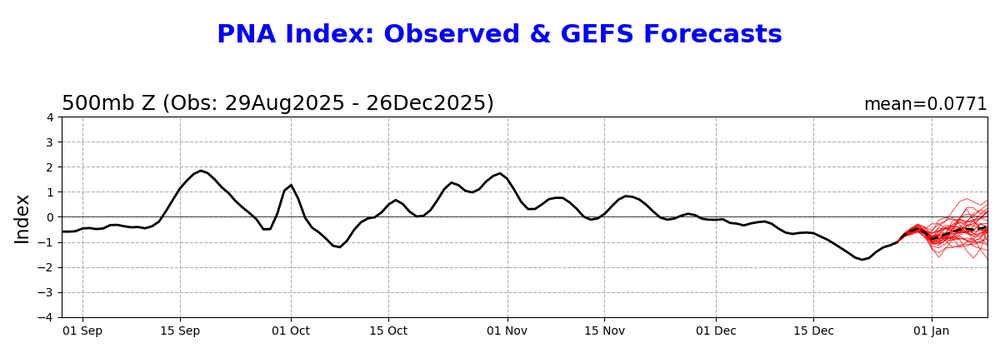
GaWx
Members-
Posts
17,844 -
Joined
Content Type
Profiles
Blogs
Forums
American Weather
Media Demo
Store
Gallery
Everything posted by GaWx
-
For -ENSO (17 seasons): 1872 10.6 1874 14.5 1886 6.6 1893 9.4 1903 15.6 1909 11.1 1915 0.7 1916 5.8 1917 13.2 1922 24.5 1926 5.7 1933 0.1 1942 9.5 1944 12.3 1995 26.1 2000 8.3 2010 36.0 Mean/median: 12.4/10.6 Interestingly, the lowest 2 Jans and highest 3 Jans were -ENSO.
-
Today’s Euro Weeklies were better overall for E US, incl 1/12-18 Today H5: Yesterday 2m: Today 2m:
-
Just looking at the 8 cases that were during -ENSO (16, 22, 26, 33, 42, 44, 95, 10), the Jan SN mean/median rises to 12.8”/9.9”.
-
Thanks. However, when I did my estimates, I took into account that the 12/29 highs would be at midnight from there through OH/IN, ATL, to BRO, etc. I did the same for 12/28 highs in the Plains/upper MW and the 12/30 highs in the NE. If anything my 31 est. for 12/28-31 is slightly high. I est. 33, 26, 29, 33 for 12/28-31. For similar reasons, there were 11:59PM lows to take into account, which I did.
-
I see ~no chance for Dec ‘25 to come in warmer than Dec ‘39’s 37.7. Through the 27th (last widespread US warm day), MTD could rise to ~38.2. But 12/28-31 are progged to avg ~31. That would bring the full Dec back down to ~37.2.
-
I see ~no chance for Dec ‘25 to come in warmer than Dec ‘39’s 37.7. Through the 27th (last widespread US warm day), MTD could rise to ~38.2. But 12/28-31 are progged to avg ~31. That would bring the full Dec back down to ~37.2.
-
-NYC now up to 7.2” snow this month, snowiest since Jan of ‘22. Thus, using stats @bluewaveand @donsutherland1got me informed about, I’m now forecasting a season total of 30” min., highest since at the very least 20-21. -NYC headed to ~5 BN this month, coldest vs norm since Mar of ‘15!
-
La Guardia was at 4.1” as of 7AM. So, all NYC area official reports are now above 4”.
-
Anyone see LaGuardia’s total? Other than that, I think every NYC official station got 4”+. C Park was up to 0.49” liquid equiv as of 7AM. Was that that far off? How much liquid was forecasted?
-
They got an additional 0.20” of liquid equivalent 7-11PM. As of 7 PM, they had had only .01”.
-
Today’s Euro Weeklies, which are overall fairly similar to yesterday, still have that new +PNA in the means for 1/12-18: This setup continues more strongly into the subsequent week, 1/19-25, than was seen yesterday:
-
-
Natural has us up 4% today. This is one of the reasons: The 12Z GEFS has this at the end: more W coast ridging than prior runs along with a pronounced weakening of the Aleutian ridge: The result is an increasing hint on the GEFS of an Arctic high plunging down ~Jan 9th-11th along with a second one to follow: The SW Canadian air that might be brought down then is very cold:
-
BAMwx video update from Michael Clark this morning:
-
We’ll see. But keep in mind that: -Jan 22 had +NAO/+AO -This was the PNA forecast as of 4 years ago today through 1/9/22: it was for still -PNA as of 1/9/22. It turned out that 1/9/22 was the first +PNA day of a 38 straight day +PNA. So, GEFS 4 years ago was blind to its start even as late as today: - Today’s GEFS PNA forecast is eerily similarly maintaining a -PNA: hmmmm Also, keep in mind that GEFS (and all of the major ensembles) have had a strong -PNA bias over the last 90 days:
-
Based on population weighted heating degree days, a good measure of energy usage, the Conus in Dec won’t be that warm at all! Pop weighted Dec temps are progged to come out to only ~1 F warmer than normal. My estimate is for Chicago to end up Dec 3 BN, Cinci 2.5 BN, Balt. 4.5 BN, Philly 4 BN, NYC 5 BN, and Boston 4.5 BN. Even the upper SE (NC) should come in slightly BN and then ~+1.5 at ATL. SL should be right at normal. DFW should be ~5 AN, DEN ~11 AN, Phoenix 6.5 AN, LA 3 AN and Seattle 4.5 AN. Based strictly on geographic area though, my guess is that the Conus will come out to ~3 AN for Dec (~1 BN E 1/2 and ~7 AN W 1/2) or ~37 F. If it comes out to 3 AN, that wouldn’t be anywhere near the records of 2023 (~5.5 AN or 40.0), 2021 (~5 AN or ~39.3 F) 2015 (~4.5 AN or ~38.6 F), and 2024 (~4 AN or 38.3 F). So, I expect Dec of 2025 on an aerial basis to come out ~3 F colder than 2023, ~2 F colder than 2021, ~1.5 F colder than 2015, and ~1.0 F colder than 2024. Also, 1939 was ~37.7 F. So, I believe that on an aerial basis that Dec of 2025 will come out no warmer than 6th warmest Dec since 1895. Also, it’s possible that 1957 and even 2014 end up warmer than 2025 if I’m a little too warm with my 37 F guess by, say, a couple of tenths, possibly dropping 2025 down to as low as 8th warmest. @TheClimateChanger
-
Thanks. Thus, we agree on aerial weighing. Do you agree that pop weighted would have been warmer in 2021?
-
Which avg Conus Christmas highs were warmer, 2021 or 2025? 1. Based on geographic area, I’d say 2025. Why? Because most of the W 1/2 including most of the Plains states as well as MO and much of TX were warmer in addition to much of the SE. Much of the NE to Ohio Valley/Michigan to Virginias/KY and much of the Midsouth were cooler. Interestingly, NYC and Chicago were about the same. 2. In terms of population weighted highs (energy usage indicator), I think 2021 was net warmer because of the high population of the NE to Ohio Valley to Michigan being warmer. 2021 forecasted highs: 2025 3:20PM EST temps:
-
78 was the high at SAV today. They’ve had 78, 78, and 75 the last 3 days. Torchy but no records, which are 81, 83, and 82. Most of their record highs in winter are in the low 80s as 70s aren’t at all uncommon. We still have 4 more days of mid to upper 70s to go before the bottom falls out. So, that would make 75ish+ 7 days in a row. Good job by the models with the warmth for a change! This is the first period they’ve done well since the week prior to Thanksgiving. They saw this coming pretty far out.
-
The best looking H5 map for cold potential for the E US in Jan on today’s Euro Weeklies is this one with a nice +PNA, which is for 1/12-18 (similar to yesterday): Just 3 days ago it still had an ugly -PNA: so there’s been a big change for an ens mean for a week long period Here’s today’s temp map for the same week (similar to yesterday): chilly but I fully expect this would turn much colder than this if the +PNA idea is right Here’s what the same week’s map had just 3 days ago, which is consistent with that ugly H5 then:
-
Merry Torchmas, fellow wx geeks, weenies, and nerds: If you’re still reading , this map isn’t for today. Rather, it’s the forecast map for the very similar Torchmas of 2021, which was then at or near the warmest Christmas on record and was from one of the favored winter analogs that folks have been following, 2021-2. That Dec also featured a strong -PNA that still wasn’t forecasted to turn to a +PNA in Jan even as late as the Boxing Day PNA forecast! It actually went positive on Jan 9th and stayed that way through Feb 15th! In addition to a chilly Jan, GSO and much of NC had a snowy Jan.
-
Regarding today’s Torchmas for much of the country, the analog 2021 is nearly a carbon copy with it then at or close to the warmest nationwide on record (this was the 12/25/21 forecast map put out just before): Like 2025, Dec of 2021 also had a very strong -PNA. Here was the PNA forecast on 12/26/21, no real end yet in site on the GEFS: (the PNA actually became positive on Jan 9th and stayed that way through Feb 15th even though this model still had no clue about that on Boxing Day): Here’s the eerily very similar current Dec of 2025 PNA and forecast:
-
Merry Christmas, fellow wx nerds/weenies! Today’s MJO forecasts aren’t bad at all for early Jan and heading into mid-Jan with them mainly on the left side and weak: GEFS: EPS: JMA:
-
Merry Christmas to snowman and everyone! A 100+ mph or 50ish m/s SPV 10 mb zonal wind peak has been forecasted for over a week on the EPS (by the way, 80-85 mph is normal…so 100 mph isn’t as anomalously high as it may sound). During these cold and often snowy E US periods in Jan, the SPV averaged 100 mph+ (peak in mph noted) keeping in mind that the Jan of 2026 peak is being forecasted at ~110-120 mph: -2025: 130 peak -Jan 1-8 of 2018, which had very cold and a very rare SE coast big snow: 130 -2016 had cold around the period of the huge NE snowstorm: 150! -2014: 120 -2nd half of 2011 had big snows/cold NE: 110 -1st half of 2010: 120 -Jan 1-17 of 2009: 150! -2nd half of 2005: 160! -2nd half of 2000: 125 -1st half of 1996: 130 -1984: 155! -Jan 1-18 of 1981: 150! -Jan 9-20 of 1979: 125 ——————————— Anyone can see all of these zonal wind peak details here, which is where I just got them from: https://acd-ext.gsfc.nasa.gov/Data_services/met/ann_data.html#ncep_clim_stats_nh
-
Today’s Euro Weeklies didn’t just hold onto all of yesterday’s widespread significant colder changes. They also cooled the only week that wasn’t cooled yesterday: Jan 5-11! Yesterday’s Jan 5-11: Today’s Jan 5-11 is below. This cooling means there are no more widespread mild weeks being forecasted in the E 1/2 of the US like there were just 2 days ago: Today’s also has a stronger suggestion of a +PNA in the means for 1/12-18:







